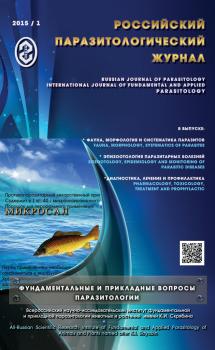Objective of research: to study the infection level of molluscs Melanoides kainarensis Starobogatov et Izzatullaev, 1980 with cercariae of trematode Philophthalmus lucipetus (Rudolphi, 1819) under conditions of Uzbekistan. Materials and methods: Cercariae and parthenitae of Ph. lucipetus of molluscs M. kainarensis from the warm spring Boshkhovuz of Samarkand region, Uzbekistan were investigated. Morphological and biological studies were carried out by well-known standard parasitological methods.Results and discussion: The research revealed that 2801 specimens of M. kainarensis were infected with cercariae and parthenitae of Philophthalmus Looss, 1899, which were identified as Ph. lucipetus. The collected cercariae and adolescariae were used for the experimental infestation with Anser anser dom., Anas platyrhynchos dom. and Gallus gallus dom. Adult parasites isolated from conjunctival sacs of infected birds were identified as Philophthalmus lucipetus. That was the first evidence for the role of M. kainarensis as the intermediate host for these trematodes.
Melanoides kainarensis, Philophthalmus lucipetus, parthenitae, cercariae, adolescariae, trematode, birds, mollusks.
Введение
Диапазон географического распространения Philophthalmus lucipetus (Rudolphi, 1819) достаточно широк. Популяции этой трематоды зарегистрированы во многих странах Европы, Азии, Африки и Америки у различных экологических групп птиц. Взрослые трематоды паразитируют в конъюнктивальном мешке и вызывают серьезное заболевание у сельскохозяйственных и охотничье-промысловых птиц. В странах СНГ данный вид зарегистрирован у Anser anser на территории Украины (Смогоржевская, 1976). Популяции Ph. lucipetus отмечены во многих странах у гусей, уток, кур, павлинов, индюков, страусов и нанду (Greve and Harrison, 1980; Mukaratirwaetal., 2005; Pinto, 2009). В качестве промежуточных хозяев этой трематоды указанными авторами были установлены моллюски Melanoidestuberсulatus,Fagotiaacicularis, Amphimelaniaholandri, Melanopsispraemorsa, Pleurocercaacutaи Tarebiagranifera (Alicata, 1962; Literaketal., 2013).
Взрослые формы Ph. lucipetus у птиц в естественных условиях Узбекистана пока не отмечены. Однако, нахождение церкарий у M. kainarensis, как нового промежуточного хозяина в Узбекистане и формирование очага инвазии только на одной территории настоятельно потребовали проведения настоящих исследований.
Целью данной работы является установление естественной инвазированности популяции M. kainarensis церкариями Ph. lucipetus в Узбекистане и воспроизведение жизненного цикла этой трематоды в условиях эксперимента.
1. Ataev G.L. The impact of temperature on the development and biology of rediae and cercariae of Philophthalmus rhionica (Trematoda). Parazitologiya [Parasitology], 1991, vol. 25, no. 4, pp. 349-359. (In Russian).
2. Galaktionov K.V., Dobrovolsky A.A. Germafroditnoe pokolenie trematod [Hermaphroditic generation of trematodes]. Leningrad, Nauka, 1987. 193 p. (In Russian).
3. Galaktionov, K.V. & Dobrovolsky, A.A. (1998) Proishozhdenie i evolyutsiya zhiznennyh tsiklov trematod [The origin and evolution of the life cycle of trematodes]. St Petersburg, Nauka, 1998. 403 p. (In Russian).
4. Ginetsinskaya, T.A. Trematody, ihzhiznennyecikly, biologiyai evolyutsiya [Trematodes, their life cycles, biology and evolution]. Leningrad, Nauka, 1968. 411 p. (In Russian).
5. Zhadin, V.I. Mollyuski presnyh i solonovatyh vod SSSR. Opredeliteli po faune SSSR [The molluscs of the fresh and briny waters of the USSR. USSR Fauna Guide]. Moscow-Leningrad, Academy of Sciences of the USSR, 1952. 374 p. (In Russian).
6. Krasnaya knigarespubliki Uzbekistan. Zhivotnye. [The Red Book of the Republic of Uzbekistan. Animals]. Tashkent, Chinor ENK, 2, 2009, pp. 40 - 41.
7. Likharev I.M., Starobogatov Ya.I. Materials on the mollusk fauna of Afghanistan. Trudy Zoologicheskogo instituta AN SSSR «Mollyuski I ih rol’ v biocenozahiformirovanii faun». [Proc. of the Institute of Zoology of the Academy of Sciences of the USSR “Mollusks and their role in biocoenoses and the formation of fauna”]. Leningrad, Nauka, 1967, 42, pp. 159 - 198. (In Russian).
8. Smogorzhevskaya A.A. Gel’minty vodoplavajushchih i bolotnyh ptits fauny Ukrainy [Helminths of the aquatic and semi-aquatic birds of the fauna of Ukraine]. Kiev, Naukova Dumka, 1976. 414 p. (In Russian).
9. Starobogatov Ya.I., Izzatullayev Z.I. Molluscs of the family Melanoididae (Gastropoda, Pectinibanchia) in Central Asia and the adjoining territories. Zoologichesky Zhurnal [Journal of Zoology], 1980, Nauka, LIX (1), pp. 23-31. (In Russian). 10. Tikhomirov I.A. Zhiznennyj tsikl Philophthalmusrhionica sp. nov. (Trematoda: Philophthalmidae). Avtoref. dis. ... kand. biol. nauk. [The life cycle of Philophthalmus rhionica sp. nov. (Trematoda: Philophthalmidae). Abst. PhD. diss. biol. sci.]. Leningrad, 1980. 20 p. (In Russian).
10.
11. Alicata J.E. Life cycle and development stages of Philophthalmus gralli in intermediate and final hosts. Journal of Parasitology, 1962, no. 48, pp. 47-54.
12. Abdul-Salam J., Sreelatha B.S., Ashkanani H. The eye fluke Philophthalmus hegeneri (Digenea: Philophthalmidae) in Kuwait Bay. Kuwait Journal of Science Eng., 2004, vol. 31(1), pp. 119-133.
13. Greve J.H., Harrison G.J. Conjunctivitis caused by eye flukes in captive-reared ostriches. Journal of the American Veterinary Association, 1980, vol.177, pp. 909-910.
14. Kanev I., Nollen P.M., Vassilev I., Radev V., Dimitrov V. Redescription of Philophthalmus lucipetus (Rudolphi, 1819) (Trematoda: Philophthalmidae) with a discussion of its identity and characteristics. Annalen des Naturhistorischen Museumsin Wien,1993, vol. 94/95B, pp. 11-34.
15. Literаk I., Heneberg P., Sitko J., Wetzel E.J., CardenasCallirgos J.M., Сapek M., ValleBasto D., Papousek I. Eye trematode infection in small passerines in Peru caused by Philophthalmus lucipetus, an agentwith a zoonotic potential spread by an invasive freshwater snail. Parasitology International, 2013, no. 62, pp. 390-396.
16. Mukaratirwa S., Hove T., Cindzi Z.M., Maononga D.B., Taruvinga M., Matenga E. First report of a field outbreak of the oriental eye-fluke, Philophthalmus gralli (Mathis & Leger 1910), in commercially reared ostriches (Struthio camelus) in Zimbabwe. Onderstepoort Journal of Veterinary Research, 2005. 72, pp. 203- 206.
17. Pinto H.A. Infecão natural de Melanoides tuberculata (Mollusca: Thiaridae) por Centrocestus formosanus (Trematoda: Heterophyidae) e por Philophthalmus gralli (Trematoda: Philophthalmidae) no Brasil. Universidade Federal de Minas Gerais Instituto de Ciencias Biologicas Belo Horizonte, 2009, pp. 55-67.
18. Radev V., Kanev I., Fried B. Comments on eye-flukes (Philophthalmidae Looss, 1819) in the genera Philophthalmus and Natterophthalmus, with a re-designation of the type-species of Natterophthalmus. Zootaxa, 2006, no. 1223, pp. 19 - 22.
19. West A.F. Studies on the biology of Philophthalmus gralli Mathis and Leger, 1910 (Trematoda: Digenea). American Midland Naturalist, 1961, 66, pp. 363-383.





